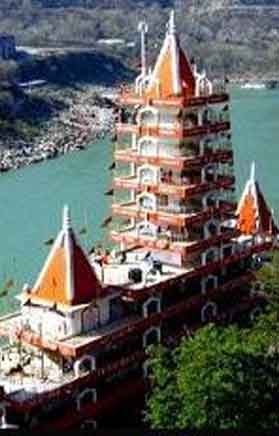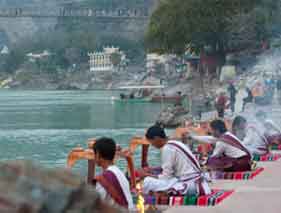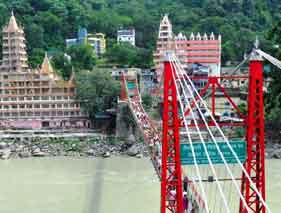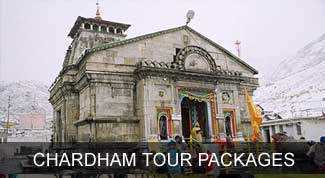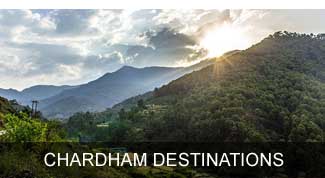Etymology
"Hrishikesha" is a name of Vishnu that means 'lord of the senses'. The place gets its name after Lord Vishnu who appeared to 'Raibhya Rishi',[3] as a result of his tapasya (austerities), as Lord Hrishikesh.[4] In Skanda Purana, this area is known as 'Kubjamrak' as Lord Vishnu appeared, under a mango tree.[2] The name Rishikesh is loosely applied to an association of five distinct sections encompassing not only the town but also hamlets and settlements on both sides of the river Ganges. These include Rishikesh itself, the commercial and communication hub; the sprawling suburb Muni-ki-Reti or the "sands of the sages"; Shivananda Nagar the home of Sivananda Ashram and the Divine Life Society founded by Swami Sivananda, north of Rishikesh; the temple section of Lakshman Jhula, a little further north; and the assorted Ashrams around Swarg Ashram on the east bank. One can reach the famous Neelakanta Maha Deva Temple from here. The Ganga Arati performed at dusk at the Triveni Ghat is popular with visitors. 'Neelkanth Mahadev Temple', situated 12 km from Rishikesh, amidst forest is also a popular local pilgrimage, along with 'Vasishtha Gufa', (Cave of sage Vasishtha), 21 km up from the town by the Ganges.
History
Rishikesh has been a part of the legendary 'Kedarkhand' (the present day Garhwal). Legends state that Lord Rama did penance here for killing Ravana, the demon king of Lanka; and Lakshmana, his younger brother, crossed the river Ganges, at a point, where the present 'Lakshman Jhula' bridge stands today, using a jute rope bridge. The 'Kedar Khand' of Skanda Purana, also mentions the existence of Indrakund at this very point. The jute-rope bridge was replaced by iron-rope suspension bridge in 1889, and after it was washed away in the 1924 floods, it was replaced by a stronger present bridge.
The sacred river Ganges flows through Rishikesh. It is here that the river leaves the Shivalik mountains in the Himalayas and flows out into the plains of northern India. Several temples, ancient as well as new, can be found along the banks of the Ganges in Rishikesh.
Yoga Center
A statue of Shiva meditating on the Ganges River
Rishikesh, sometimes nicknamed "the world capital of Yoga", has numerous yoga centres that also attract tourists. It is believed that meditation in Rishikesh brings one closer to attainment of moksha, as does a dip in the holy river that flows through it. Rishikesh is world famous for Rafting and Adventure. Rafting season starts from the month of March and ends in July. Rishikesh is also home to the 120-year old Kailas Ashram Brahmavidyapeetham, an institution dedicated to preserve and promote the traditional Vedantic Studies. Prominent personalities such as Swami Vivekananda, Swami Rama Tirtha and Swami Shivananda have studied in this institution.
In February 1968, The Beatles visited the now-closed Maharishi Mahesh Yogi's ashram in Rishikesh.[6] John Lennon recorded a song titled, 'The Happy Rishikesh Song'.[7][8] The Beatles composed nearly 48 songs during their time at the Maharishi's ashram, many of which appear on the White Album. Several other artists visited the site to contemplate and meditate
Geography
Rishikesh is located at 30°06'12?N 78°17'41?E / 30.103368°N 78.294754°E / 30.103368; 78.294754. It has an average elevation of 372 metres (1,745 feet).
The Tehri dam is just 80 km uphill on the way to Gangotri. Rishikesh is the starting point for traveling to the sites that form the Char Dham pilgrimage - Badrinath, Kedarnath, Gangotri, and Yamunotri.
Demographics
As of 2001[update] India census,[9] Rishikesh had a population of 59,671. Males constitute 56% of the population and females 44%. Rishikesh has an average literacy rate of 85%, higher than the national average of 59.5%: male literacy is 90%, and female literacy is 78%. In Rishikesh, 12% of the population is under 6 years of age.
Adventure sports
Rishikesh is becoming a popular spot for white water rafting enthusiasts, both from India and abroad, as it offers medium to rough rapids in the course of river Ganges, with rapids rated class 3 and class 4.khushi[10] It is also a center for hiking and backpacking.
Best Time to Visit Rishikesh
The best time to visit Rishikesh throughout the year
How to Reach Rishikesh ?
By Air :
There are no airports in Rishikesh itself. But the Jolly Grant airport at Dehradun is just 35 km from Rishikesh. Indian Airlines and Air Deccan operates regular flights to and from Dehradun to important cities like Delhi.
By Train :
The railway station nearest to Rishikesh is Hardwar. Hardwar is a major railhead and trains plying from Allahabad, Kolkata, Delhi and so on stop at Haridwar.
By Road :
An extensive network of roads connect Rishikesh to the other cities within Uttaranchal and India, such as Haridwar, Agra, Chandigarh, Dehradun, Delhi and Nainital. Regular bus services and taxis on hire are easily available for traveling to and from Rishikesh to these places.
